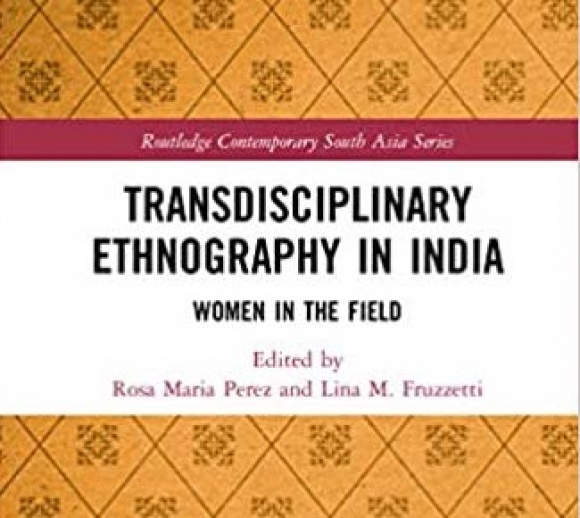
Fieldwork does not come with a guidebook; most of the understanding gained from it is in hindsight. Transdisciplinary Ethnography in India: Women in the Field, edited by Rosa Maria Perez and Lina M. Fruzzetti and published by Routledge in 2022 is an amalgam of many such reflections of academics who have conducted ethnography as women in India. In addition to depicting the authors’ fieldwork experiences, the book also emphasises the methodological dilemmas of narrative voice and the researcher’s social identities. The book succeeds as a researcher’s companion to contemplating the question of ethnography, focusing on women’s experiences as fieldworkers. The extent of the researchers’ ‘belonging’ in the field runs as a constant theme. In doing so, the authors break assumptions regarding how their identities and those of their interlocutors intersect.
In the first chapter, Rita Kothari learns that the similarity of her language (Gujarati) and gender with her participants (Sindhi-speaking women in Kutch) did not guarantee easy communication or access. In fact, her knowledge of the language led the women to censor themselves at various points. For Rosa Perez, in chapter eight, her unfamiliarity with Gujarati led to her keenly observing the Vankar women’s familial dynamics and learning to communicate with non-verbal cues. Showing utmost care not to misrepresent their realities, given their social and economic vulnerability, Perez nevertheless recognises that ‘our worlds do not connect as our hearts deeply do’ (p. 142).
In chapter three, we see that Lina Fruzzetti’s identity as a married woman and a mother gave her access to inquire about women’s lifecycle rituals in rural Bengal. However, despite her brown skin, her caste-outsider status also meant that her presence in people’s homes or access to communal water was considered polluting. Inês Lourenço and Rita Cachado, in their study of diasporic Hindu-Gujaratis (chapter seven), placed themselves as cultural children (p. 116) in their host families, showing eagerness to learn about their cultural practices and being treated like literal daughters. The difference in their experiences with men and women organising a religious event shows women’s preoccupation with ritual purity, thereby being less trustful of the researchers. According to the authors, this balanced out the power relations in the field. In chapter five, Hia Sen’s reflections on her fieldwork experience in Kolkata led her to recognise the intertwined nature of age and gender. Sen’s appearance as a 24-year-old woman of medium height led to the disbelief of her interlocutors’ families about her being a researcher. She remembers being chaperoned to the taxi stand by her 12-year-old male interlocutor, an act that again refutes the presumed power position of the researcher.
Payel Mukherjee’s work among the homeless women in Ahmedabad (chapter two) shows their strategies of practising religion and culture within symbolic boundaries of the home. The researcher’s relatively new acquaintance with the city contributed to her critical understanding of the homeless women’s placemaking on its pavements, making her wonder if the physical conception is mandatory for making homes. In chapter four, Sreeparna Chattopadhyay walks us through the emotional upheavals she experienced while conducting fieldwork among domestic violence survivors in Mumbai. The experiences conveyed by her interlocutors, while seemingly devoid of emotions themselves, had a profound impact on the researcher. In conversation with the survivors, her social location as a married, educated, and child-free woman put her in a state of liminality. Her takeaway is that emotionally open renderings of suffering convey a more authentic account than datasets.
Maitreyee Chaudhari’s fieldwork among Bengali migrants in Delhi and Indian Americans in the USA (chapter six) initially revealed the similarities between these groups, given her position as an ‘insider’ in both contexts. However, this early supposition broke apart when the unique aspects of her own migrant experiences contributed to a nuanced understanding of their specificities. In conclusion, she highlights the importance of the migrant communities’ interaction with the state in moulding cultural identity and the role of academic traditions in naming groups. Swarna Rajagopalan, in chapter nine, reflects upon the multitude of meanings that the term ‘field’ has come to mean to her, including the site of research, the lives and contexts of people we study, disciplinary boundaries, and the scholarship of those working in India as the gazer and gazed. The fluidity of these spaces with the researcher’s identity leads her to state that ‘there is no separate ‘field’ outside of our experiences’ (p. 147-148).
Despite previous works on the theme of ‘women in the field’, this volume is original in tackling the ‘native’ vs ‘non-native’ researcher debate. In so doing, the lasting influence of the researcher’s identities, and therefore subjectivity, upon the study becomes evident. The equation of womanhood with gender could have been given more space for discussion in the volume, but the conclusion is a starting point to that end. The text is a helpful addition to anyone interested, across disciplines, in qualitative and reflexive fieldwork.
***
Sambhavi Ganesh is a PhD student at the Centre for South Asian Studies, University of Edinburgh, UK. Her research seeks to understand the construction and performance of womanhood among Tamil Brahmins amidst their recent advances in access to public life.